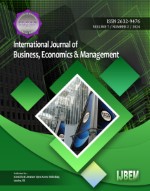Implementation of carbon accounting in green buildings at the Ministry of Public Works and Public Housing (PUPR)
Keywords:
Carbon Accounting, Green Buildings, Ministry of Public Works, Public HousingAbstract
This research aims to describe the implementation of carbon accounting in green buildings in the Ministerial Building of the Ministry of PUPR. This research explores more deeply how carbon accounting practices can be applied and provide benefits in efforts to reduce emissions in green buildings. This study used qualitative research methods. This research uses a case study approach as an in-depth qualitative methodology. The location of this research is the Ministerial Building of the Ministry of PUPR which is located at Jl. Pattimura No. 20 South Jakarta. For the validity of this research data, researchers used triangulation techniques. The results of research on the implementation of carbon accounting and the amount of carbon produced in the Ministerial Building of the Ministry of PUPR, namely the amount of carbon accounting from electricity use in 2023 was recorded at 1,829.3 tonco2e, the amount of carbon accounting from water use in 2023 resulted in carbon accounting of 8.07 tonco2e, the implementation of reduction Carbon emissions and the intensity of building use cause an increase in emissions in the 2019-2023 period. Trend analysis of carbon emissions from water use peaked in 2013 at 10,556 kgco2e.
Downloads
References
Al-Muhanadi, M., Al-Fadhel, H., & Al-Jalahma, A. (2020). How can the Accounting Profession Contribute to the Reduction of CO2 Emissions in the GCC Region?. In 2020 Second International Sustainability and Resilience Conference: Technology and Innovation in Building Designs (51154) (pp. 1-4). IEEE.
Ascui, F., & Lovell, H. (2012). Carbon accounting and the construction of competence. Journal of Cleaner Production, 36, 48-59. https://doi.org/10.1016/j.jclepro.2011.12.015
Asriana, N., & Koerniawan, M. D. (2020). TOD Model through Low Carbon City Concept in Urban Design (case study: Palembang, Indonesia). In IOP Conference Series: Earth and Environmental Science (Vol. 532, No. 1, p. 012017). IOP Publishing.
Creswell, J. W. (2015). Penelitian kualitatif & desain riset. Yogyakarta: pustaka pelajar, 1-634.
Csutora, M., & Harangozo, G. (2017). Twenty years of carbon accounting and auditing–a review and outlook. Society and Economy, 39(4), 459-480.
Eo, S. J., & Kim, Y. H. (2014). A Study on Carbon Emission Analysis and Carbon Reduction Effect for Public Buildings-Focused on the public offices in Cheongju city. Journal of the Architectural Institute of Korea Planning & Design, 30(2), 203-210.
Herawati, A., Sutrisno, T., & Purwanti, L. (2023). Determinants of auditor’s ability to detect fraud with professional skepticism as moderation at the inspectorate general of the ministry of public works and public housing. International Journal of Business, Economics & Management, 6(2), 123-133. https://doi.org/10.21744/ijbem.v6n2.2132
Leung, C. K. Y., Sarpca, S., & Yilmaz, K. (2012). Public housing units vs. housing vouchers: Accessibility, local public goods, and welfare. Journal of Housing Economics, 21(4), 310-321. https://doi.org/10.1016/j.jhe.2012.08.002
Li, Q., Long, R., Chen, H., Chen, F., & Wang, J. (2020). Visualized analysis of global green buildings: Development, barriers and future directions. Journal of Cleaner Production, 245, 118775. https://doi.org/10.1016/j.jclepro.2019.118775
Meehan, F., Tacconi, L., & Budiningsih, K. (2019). Are national commitments to reducing emissions from forests effective? Lessons from Indonesia. Forest Policy and Economics, 108, 101968. https://doi.org/10.1016/j.forpol.2019.101968
Mustaffa, N. K., Isa, C. M. M., & Ibrahim, C. K. I. C. (2021). Top-down bottom-up strategic green building development framework: Case studies in Malaysia. Building and Environment, 203, 108052. https://doi.org/10.1016/j.buildenv.2021.108052
Permana, A. Y., Wijaya, K., Nurrahman, H., & Permana, A. F. S. (2020). Pengembangan Desain Micro House Dalam Menunjang Program Net Zero Energy Buildings (Nze-Bs). Jurnal Arsitektur Arcade, 4(1), 73-81.
Ramadhani, D. (2012). Analisis Kinerja UKM Pengolahan Keripik Pisang Di Bandar Lampung Dengan Menggunakan Metode Quality Function Deployment.
Regina, R., Tjung, L. J., & Priyendiswara, P. A. (2019). Rencana Pengelolaan Green Building Dengan Pendekatan Building Environment Management (BEM). Jurnal Sains, Teknologi, Urban, Perancangan, Arsitektur (Stupa), 1(2), 2181-2190.
Satterthwaite, D. (2008). Cities' contribution to global warming: notes on the allocation of greenhouse gas emissions. Environment and urbanization, 20(2), 539-549.
Schaltegger, S., & Csutora, M. (2012). Carbon accounting for sustainability and management. Status quo and challenges. Journal of Cleaner Production, 36, 1-16. https://doi.org/10.1016/j.jclepro.2012.06.024
Shao, L., Chen, G. Q., Chen, Z. M., Guo, S., Han, M. Y., Zhang, B., ... & Ahmad, B. (2014). Systems accounting for energy consumption and carbon emission by building. Communications in Nonlinear Science and Numerical Simulation, 19(6), 1859-1873. https://doi.org/10.1016/j.cnsns.2013.10.003
Son, B. G., Roscoe, S., & Sodhi, M. S. (2024). Dynamic capabilities of global and local humanitarian organizations with emergency response and long-term development missions. International Journal of Operations & Production Management.
Teddy, S. D., & Priatman, J. (2018). Kajian Penerapan Prinsip Water Conservation Sesuai Standar Greenship New Building Versi 1 . 2 Studi Kasus?: Gedung P1 Dan P2 Universitas Kristen Petra Surabaya. 5(2), 9–16.
UNFCC. (n.d.). What is the Kyoto Protocol? | UNFCCC. Retrieved 27 February 2024, from https://unfccc.int/kyoto_protocol
Warjiyono. (2016). Penerapan Green Computing.
Wong, P. S., Holdsworth, S., Crameri, L., & Lindsay, A. (2019). Does carbon accounting have an impact on decision-making in building design?. International Journal of Construction Management, 19(2), 149-161.
Wong, P. S., Lindsay, A., Crameri, L., & Holdsworth, S. (2015). Can energy efficiency rating and carbon accounting foster greener building design decision? An empirical study. Building and Environment, 87, 255-264. https://doi.org/10.1016/j.buildenv.2015.02.006
Zhang, J., & Xu, L. (2015). Embodied carbon budget accounting system for calculating carbon footprint of large hydropower project. Journal of Cleaner Production, 96, 444-451. https://doi.org/10.1016/j.jclepro.2013.10.060
Zhang, Y., Wu, Q., & Fath, B. D. (2018). Review of spatial analysis of urban carbon metabolism. Ecological Modelling, 371, 18-24. https://doi.org/10.1016/j.ecolmodel.2018.01.005
Published
How to Cite
Issue
Section
Copyright (c) 2024 International journal of business, economics & management

This work is licensed under a Creative Commons Attribution-NonCommercial-NoDerivatives 4.0 International License.
Articles published in the International Journal of Business, Economics & Management (IJBEM) are available under Creative Commons Attribution Non-Commercial No Derivatives Licence (CC BY-NC-ND 4.0). Authors retain copyright in their work and grant IJBEM right of first publication under CC BY-NC-ND 4.0. Users have the right to read, download, copy, distribute, print, search, or link to the full texts of articles in this journal, and to use them for any other lawful purpose.
Articles published in IJBEM can be copied, communicated and shared in their published form for non-commercial purposes provided full attribution is given to the author and the journal. Authors are able to enter into separate, additional contractual arrangements for the non-exclusive distribution of the journal's published version of the work (e.g., post it to an institutional repository or publish it in a book), with an acknowledgment of its initial publication in this journal.














